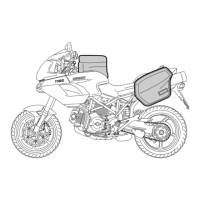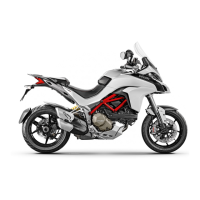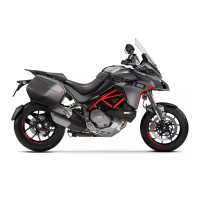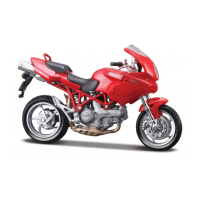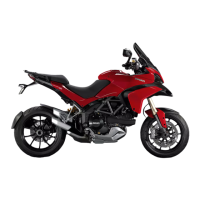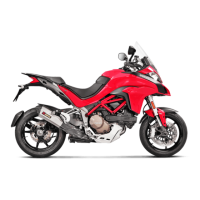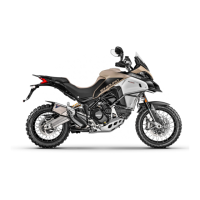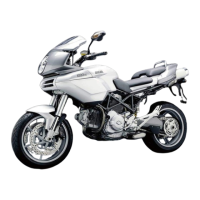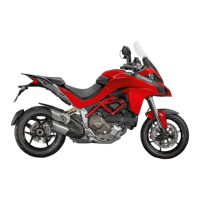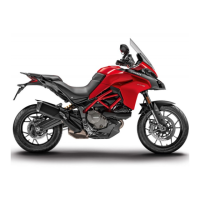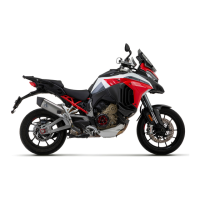Do you have a question about the Ducati MULTISTRADA 1100 and is the answer not in the manual?
Details about the motorcycle's warranty coverage and conditions.
Explains symbols used for warnings, notes, and directional cues.
Crucial safety advice to read before operating the motorcycle.
Details on maximum weight and luggage distribution for safe riding.
Locating and identifying the motorcycle's frame and engine numbers.
Diagram and list of control locations on the motorcycle.
Details the functions displayed on the LCD screen, including indicators.
Instructions on how to adjust display settings and view parameters.
Explains the display for engine oil temperature and its indicators.
Steps to set the clock and access additional display functions.
Displays for fuel consumption, remaining range, and speed.
Control of backlight, warning lights, and automatic headlight switch-off.
Explains the anti-theft immobilizer system and its operation.
Details the red and black keys, code card, and their security functions.
Step-by-step guide to bypass the immobilizer using the throttle.
How the immobilizer functions during startup and how to get duplicate keys.
Explains the four positions of the ignition switch and steering lock.
Details the functions of the light selector, turn signals, horn, and flashers.
How to adjust the clutch lever and its proper use.
Operation of the engine stop switch, starter, and throttle twistgrip.
How to adjust the front brake lever for reach and its use.
How to operate the rear brake pedal and gearchange pedal.
Steps to adjust the gearchange and rear brake pedal positions.
Visual guide to the placement of major motorcycle parts.
Instructions for opening and closing the fuel tank cap.
How to use the seat lock and helmet holder for security.
How to open and close the document compartment.
Instructions for using the sidestand safely and checking its mechanism.
How to adjust front fork damping and spring preload.
How to adjust rear shock absorber damping and spring preload.
How to adjust mirrors for optimal visibility and secure them.
Procedure to adjust rear ride height via tie-rod.
Guidelines for breaking in the engine, brakes, and suspension.
Critical checks for fuel, oil, brakes, tires, controls, and lights.
Steps for turning on the ignition and verifying dashboard indicators.
Techniques for starting from a stop, shifting gears, and braking.
Steps to safely stop the motorcycle and secure it for parking.
How to refuel safely, avoid overfilling, and use correct fuel.
Details on items stored in the fairing compartment, including tools.
Instructions for safely removing and reattaching fairing panels.
Information about fitting side panniers and the available kit.
Procedures for checking and maintaining brake and clutch fluid levels.
How to check brake pad wear and when replacement is needed.
Lubrication for throttle cables and sidestand pivot.
How to adjust throttle cable free play.
Detailed instructions for safely charging the motorcycle battery.
Method for checking chain tension and swingarm bolt safety.
How to clean and lubricate the drive chain using specific products.
Guide to accessing and replacing high and low beam headlight bulbs.
Procedure for replacing the parking/side light bulb.
How to replace bulbs in the front turn indicators integrated into mirrors.
Steps to remove and replace rear turn indicator bulbs.
How to access and replace rear light mounting bulbs.
Procedure for verifying and correcting headlight beam alignment.
Recommended front and rear tyre pressures for optimal performance.
Legal and safety requirements for tyre tread depth.
How to check engine oil level and add oil if necessary.
Inspecting spark plugs for condition and measuring the electrode gap.
Best practices for washing the motorcycle to prevent damage.
Steps to prepare the motorcycle for extended periods of non-use.
List of maintenance operations to be done by authorized dealers.
Key physical dimensions and weight limits of the motorcycle.
Details on fuel, oil, and fluid specifications and quantities.
Information on engine type, displacement, power, and torque.
Details on performance, spark plugs, fuel, and exhaust systems.
Information on the clutch, gearbox, and gear ratio specifications.
Specifications for the front brake disc, calipers, and master cylinder.
Details of the frame, wheels, and tyre specifications.
Details on the front fork and rear suspension linkage.
List of available colour options with corresponding codes.
Listing of the primary components within the electrical system.
Information on the location and layout of the fuse boxes.
Standard abbreviations for wire colours used in diagrams.
Reporting safety defects and noise warranty for the USA market.
Details on emission control systems, tampering, and problem symptoms.
Essential advice for safe operation and accident prevention.
How to locate the Vehicle Identification Number (VIN) and frame numbers.
Description of the components of the California evaporation emission system.
Details on the emission control system warranty, coverage, and limitations.
A logbook for recording scheduled maintenance service.
Details about the motorcycle's warranty coverage and conditions.
Explains symbols used for warnings, notes, and directional cues.
Crucial safety advice to read before operating the motorcycle.
Details on maximum weight and luggage distribution for safe riding.
Locating and identifying the motorcycle's frame and engine numbers.
Diagram and list of control locations on the motorcycle.
Details the functions displayed on the LCD screen, including indicators.
Instructions on how to adjust display settings and view parameters.
Explains the display for engine oil temperature and its indicators.
Steps to set the clock and access additional display functions.
Displays for fuel consumption, remaining range, and speed.
Control of backlight, warning lights, and automatic headlight switch-off.
Explains the anti-theft immobilizer system and its operation.
Details the red and black keys, code card, and their security functions.
Step-by-step guide to bypass the immobilizer using the throttle.
How the immobilizer functions during startup and how to get duplicate keys.
Explains the four positions of the ignition switch and steering lock.
Details the functions of the light selector, turn signals, horn, and flashers.
How to adjust the clutch lever and its proper use.
Operation of the engine stop switch, starter, and throttle twistgrip.
How to adjust the front brake lever for reach and its use.
How to operate the rear brake pedal and gearchange pedal.
Steps to adjust the gearchange and rear brake pedal positions.
Visual guide to the placement of major motorcycle parts.
Instructions for opening and closing the fuel tank cap.
How to use the seat lock and helmet holder for security.
How to open and close the document compartment.
Instructions for using the sidestand safely and checking its mechanism.
How to adjust front fork damping and spring preload.
How to adjust rear shock absorber damping and spring preload.
How to adjust mirrors for optimal visibility and secure them.
Procedure to adjust rear ride height via tie-rod.
Guidelines for breaking in the engine, brakes, and suspension.
Critical checks for fuel, oil, brakes, tires, controls, and lights.
Steps for turning on the ignition and verifying dashboard indicators.
Techniques for starting from a stop, shifting gears, and braking.
Steps to safely stop the motorcycle and secure it for parking.
How to refuel safely, avoid overfilling, and use correct fuel.
Details on items stored in the fairing compartment, including tools.
Instructions for safely removing and reattaching fairing panels.
Information about fitting side panniers and the available kit.
Procedures for checking and maintaining brake and clutch fluid levels.
How to check brake pad wear and when replacement is needed.
Lubrication for throttle cables and sidestand pivot.
How to adjust throttle cable free play.
Detailed instructions for safely charging the motorcycle battery.
Method for checking chain tension and swingarm bolt safety.
How to clean and lubricate the drive chain using specific products.
Guide to accessing and replacing high and low beam headlight bulbs.
Procedure for replacing the parking/side light bulb.
How to replace bulbs in the front turn indicators integrated into mirrors.
Steps to remove and replace rear turn indicator bulbs.
How to access and replace rear light mounting bulbs.
Procedure for verifying and correcting headlight beam alignment.
Recommended front and rear tyre pressures for optimal performance.
Legal and safety requirements for tyre tread depth.
How to check engine oil level and add oil if necessary.
Inspecting spark plugs for condition and measuring the electrode gap.
Best practices for washing the motorcycle to prevent damage.
Steps to prepare the motorcycle for extended periods of non-use.
List of maintenance operations to be done by authorized dealers.
Key physical dimensions and weight limits of the motorcycle.
Details on fuel, oil, and fluid specifications and quantities.
Information on engine type, displacement, power, and torque.
Details on performance, spark plugs, fuel, and exhaust systems.
Information on the clutch, gearbox, and gear ratio specifications.
Specifications for the front brake disc, calipers, and master cylinder.
Details of the frame, wheels, and tyre specifications.
Details on the front fork and rear suspension linkage.
List of available colour options with corresponding codes.
Listing of the primary components within the electrical system.
Information on the location and layout of the fuse boxes.
Standard abbreviations for wire colours used in diagrams.
Reporting safety defects and noise warranty for the USA market.
Details on emission control systems, tampering, and problem symptoms.
Essential advice for safe operation and accident prevention.
How to locate the Vehicle Identification Number (VIN) and frame numbers.
Description of the components of the California evaporation emission system.
Details on the emission control system warranty, coverage, and limitations.
A logbook for recording scheduled maintenance service.
| Front Brake | 2 x 320mm discs, 4-piston calipers |
|---|---|
| Rear Brake | 245mm disc, 2-piston caliper |
| Seat Height | 850mm (33.5 in) |
| Fuel Capacity | 20 L (5.3 US gal) |
| Engine | L-twin, 2 valves per cylinder Desmodromic; air cooled |
| Fuel System | Electronic fuel injection, 45 mm throttle body |
| Transmission | 6 speed |
| Frame | Tubular steel trellis |
| Front Suspension | 43 mm upside-down fork, fully adjustable |
| Rear Suspension | Progressive linkage with fully adjustable monoshock |
| Power | 95 hp (69.9 kW) @ 7750 rpm |
